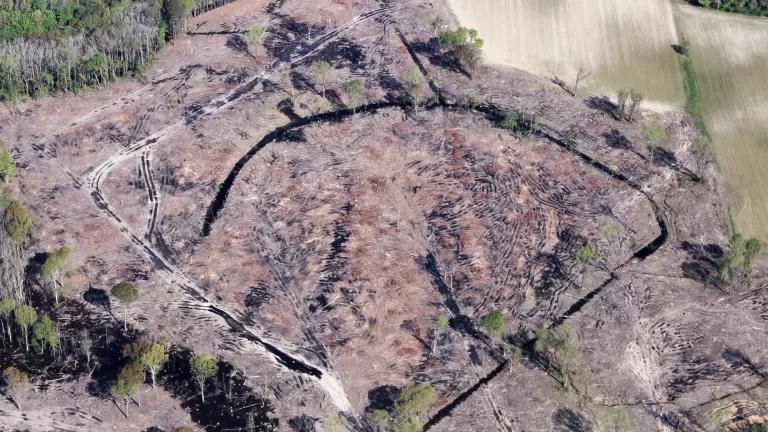Salmon: A Natural Climate Solution
We must not forget our dependence on the biodiversity that makes this planet livable. After all, these fish grow the forests.

Spawning sockeye salmon
We must not forget our dependence on the biodiversity that makes this planet livable. After all, these fish grow the forests.
This blog is the third in a four-part series that explores the role wildlife plays in boosting ecosystem resilience—and how thriving biodiversity supports our own efforts to mitigate climate change. Read our other blogs on wolves, sea otters, and beavers by clicking the links.
As salmon decline and threaten to disappear from most of their historic spawning range in North America, we must reckon with the question while confronting the existential climate crisis: How hard will we fight to save a fish?
The thing is, we are talking about so much more than a fish. Salmon are the main artery of the Western food chain, feeding everything from insects to orcas. Salmon are linchpins to the way of life, well-being, and vibrant future of West Coast Native peoples. Salmon fire the economies of hardworking coastal and rural river communities from Monterey, California, to Sitka, Alaska, to Riggins, Idaho. And there is more. Salmon are a nature-based solution to combating climate change.
Most people recognize that coastal, riparian, and forest ecosystems help capture and store carbon. This storage benefit is big. About one-third of the CO2 released from burning fossil fuels is absorbed by forests every year, according to the IUCN. The thing we are just beginning to fully appreciate on the West Coast is that in this region, trees need salmon.

Salmon hatch from eggs in freshwater rivers and streams, and then they head out to the Pacific Ocean, where they grow fat. Sometime later, they migrate home as adults to the inland waters of their birth to spawn and die. The bodies of salmon remain in the water, where they decompose and slowly feed not just the base of a web of wildlife, but they also fertilize the region’s shrubs and trees. Tens of millions of salmon make this journey each year, acting all together as a magnificent natural conveyor belt that moves marine-derived nitrogen into coastal and inland forest ecosystems. The fish grow the forest.
Nitrogen is scarce in most inland Northwest forests. So it’s not surprising that around rivers with abundant salmon populations, trees have been found to grow more than three times faster than trees next to rivers without salmon. For example, scientists found that with salmon, Sitka spruce (Picea sitchensis) take 86 years to grow about 20 inches thick. Without salmon, it takes them 307 years to reach the same size. The animals that feed on salmon—from bears to bugs (a salmon carcass can feed 55 insect species)—help carry these nutrients across the woods and wetlands and as far inland as the Rocky Mountains.
Our trees are not getting what they need and, therefore, our forests are not storing carbon at their full ecological potential. Scientists estimate the historic biomass of salmon returning to the Northwest to be 160 to226 million kilograms. The number of fish now returning to these rivers has a biomass of 11.8 to 13.7 million kilograms. The dramatic decline in salmon across the Northwest means that only about 6 percent to 7 percent of the marine-derived nitrogen once delivered is currently coming home. Any farmer can tell you about the importance of fertilizer. If we want to realize the full carbon storage potential of our forest ecosystems, salmon recovery should be at the top of the list.

Salmon offer just one more way that the biodiversity crisis and climate crisis are inextricably tangled together. We undermine our efforts in either fight if we fail to address them together. That’s part of why while we combat climate change, we are also working hard to protect salmon across the West Coast, from California to the Northwest and into Alaska. You can learn more about our work to protect salmon and salmon-based cultures in the Sacramento–San Joaquin River Delta, the Columbia–Snake River basin, the Tongass rainforest, and Bristol Bay.
Fighting for these natural systems is also connected to the larger goal of ensuring that the United States gets on the path of protecting 30 percent of its land and 30 percent of its ocean areas by 2030. This objective is about more than a change in the climate. It’s a change in the culture.
In the preface to Caw Pawa Laakni—They Are Not Forgotten, Dr. Eugene S. Hunn shares a Sahaptin Columbia River basin story about how salmon, steelhead, and huckleberries were placed in the landscape by Coyote “to make the world hospitable for people.” Salmon continue to be honored as a first food by Indigenous Peoples throughout the Northwest and Alaska. Combating climate change will take more than smart technologies and electric vehicles. Those things are important. But we must not forget our dependence on and responsibilities to the incredibly rich and helpful diversity of plants and animals that makes this planet livable. Fighting for the fish is fighting for all life, including our own.



